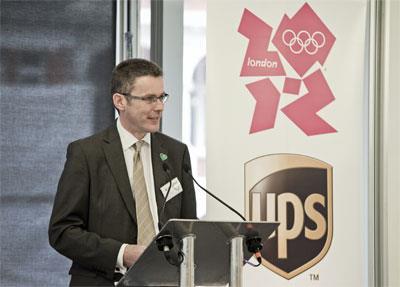
Although the heroics of Team GB at London 2012 already feel like a long time ago, UPS, which was named logistics and express delivery partner to the Games in January 2009, doesn’t officially wrap up its involvement until the end of this month.
The winding down and effective closure of two warehouses, in Stevenage and the Port of Tilbury, will bring the curtain down on a supply chain that handled 30 million items, and dealt with everything from demanding broadcasters, to 2010’s ash cloud threat.
I predict a riot
Alan Williams, UPS director of London 2012 sponsorship and operations, is relaxed and personable when MT meets him in central London. However, listening to some of the hurdles his team had to overcome, one suspects even the urbane Williams must have come close to breaking point at times.
Williams explains the UPS Games mentality as “plan on the known knowns, and the known unknowns, as it’s the unknown unknowns that you’ve got to react to”.
One of these became known in 2010 when the Icelandic volcanic ash cloud shut down European airspace. However, it was something much closer to home that provided an unforeseen challenge ahead of a series of test events – the London riots of August 2011.
“The most serious impact this had was on the cycle road race. We were doing [crowd] barrier deployment through a subcontractor,” says Williams. Normally the barriers are deployed where required, ready for the appropriate road junctions to be closed on race day. But the police said to UPS that unsecured barriers could be missiles in the wrong hands. This was the Friday lunchtime with the test event set for Saturday.
“So Friday afternoon we bought 3.5km of marine chain from a factory in Birmingham, collected it and brought crews in to cut it into 4m lengths. We bought every padlock we could in the South East, and on the Saturday morning we went out and started chaining barriers. We stood that team down, and at 3am the next day had another team cut the chain on the barriers so they could be deployed,” Williams says.
Demand troughs
At peak, UPS had 1,300 people on its Olympics team. There were 36 competition venues nationally but 184 locations in all. UPS ran its Olympics programme separately to its day-to-day business and, at its busiest time, had an Olympic fleet of up to 70 tractors, 80 18-tonne rigids, and 50 other vehicles. This included a range of green vehicles, such as 10 bio-methane trucks that now operate in the day-to-day operation, electric vehicles, and three bespoke Fuso Canter hybrid’s for the media.
“We did a bit of everything as there was no one solution for people and equipment [on this scale].

The fleet size needed was based on peak times, so there were certain times in the programme that we had demand troughs. So what we did with that fleet, how we used it for other things at those times, meant it was a dynamic model,” Williams says.
When the Paralympics finished, UPS faced bump out. While it had nine months to bump in the required equipment, from furniture (that came flat packed and had to be assembled for the Athletes’ Village), to computers, sports equipment, programmes and merchandising, it had just two months to take it out.
Long-term gain
“We’re really pleased with how it worked operationally,” says Williams. “It worked as we hoped and we didn’t make the front pages [for the wrong reasons].
“We were there as a sponsor to showcase our operational expertise, this equals growth and the growth we’ve experienced as part of the Olympics has been what we needed it to be,” he says.
Political engagement and night-time deliveries, will be the enduring benefit for road transport as a whole.
On a personal note, Williams has his own favourite memory. “It was really cool seeing UPS trucks coming out of the Tower of London every morning loaded with medals for the athletes,” he says.














